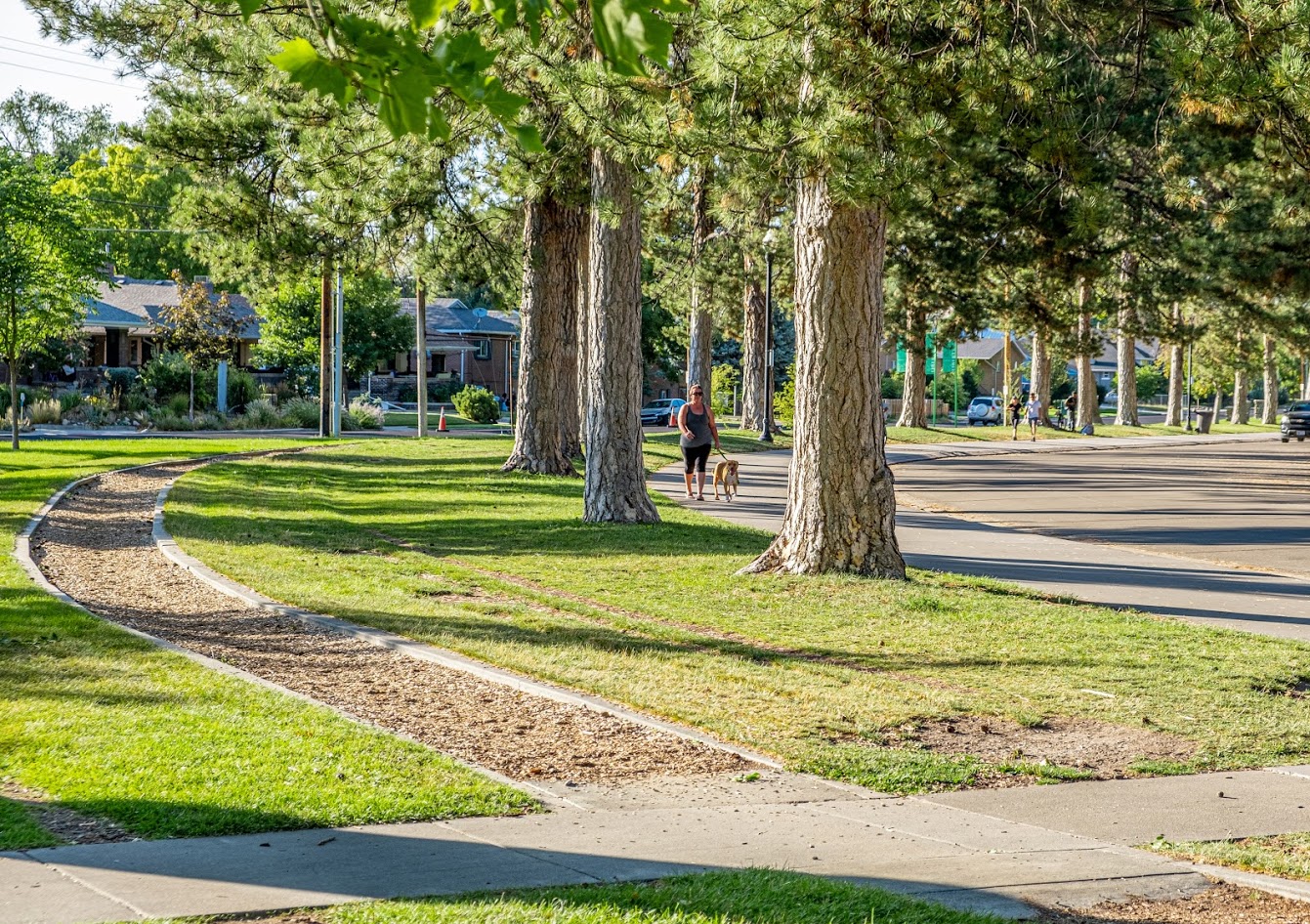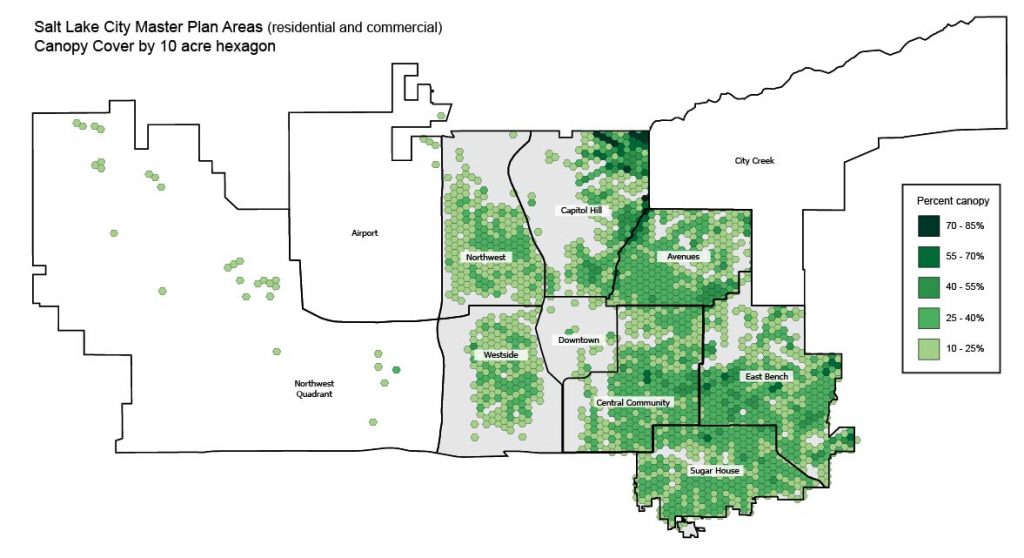Haga clic aquí para ver la informacion en Español

Urban Forest Action Plan
Salt Lake City is working to expand our Urban Forest.
Urban forests are vital contributors to thriving cities. When properly planned, planted, and protected, urban forests promote both public and environmental health. Our urban forest is an asset that Salt Lake City residents treasure.
The Urban Forest Action Plan will provide goals, objectives, and actions to realize the vision for the urban forest established in Plan Salt Lake, adopted in 2015. Under the guiding principle of “Beautiful City,” the plan asserts:
Salt Lake City residents and visitors recognize our green network, including our urban forest, parks, and street trees, as one of our greatest assets. Our green network plays an important role in shaping our streetscapes and urban form. It enhances the livability of the City, improving air and water quality while providing shade, buffering noises, and enhancing walkability and streetscapes citywide. We recognize that this green network contributes to a healthy and beautiful city. We will continue to make its maintenance and expansion a priority (31).
The urban forest is a modified natural system that is a public good and has long-term value like constructed systems such as public utilities and streets.The urban forest provides a wide range of benefits, including:
- Improved air and water quality
- Reduced energy consumption
- Improved public health outcomes
- Improved urban design in neighborhoods and business districts.
The urban forest plays a critical role in reducing the environmental impacts of Salt Lake City’s rapid development and population growth. The interrelated imperatives of climate change adaptation and sustainable urban design and planning approaches require a reassessment of the City’s existing policies and practices.
To ensure the Urban Forest’s benefits are distributed equitably across the city, Salt Lake City needs to plan for the health and expansion of the urban forest. The plan will develop goals, objectives, and actions to:
- Ensure adequate protection of the urban forest as a public good through land use policy and land management practice.
- Codify the City’s commitment to sustainable infrastructure.
- Value the urban forest for the entire range of ecosystem and quality-of-life benefits it provides.
- Provide solutions in the right-of-way that will accommodate trees, access, and utilities where they compete for the same space.
- Guide urban forest priorities and preservation to project reviewers and inspectors.
The timeline for the plan’s development is approximately 12 months, with projected completion in early spring 2022.
Uban Forest Action Plan // First Draft
As chapters are completed, they will be posted here. Chapters 1- 4 are currently available to the public. Chapter 5, which will recommend goals, objectives, and actions for our urban forest is still in process. The full document will be posted in Spring of 2022. Public comments and feedback are welcome at any time throughout this process.
Urban Forest Action Plan – (Draft)
- Table of Contents
- Executive Summary
- Chapter 1: Introduction
- Chapter 2: Salt Lake City Urban Forest Analysis
- Chapter 3: Livability + the Urban Forest in Salt Lake City
- Chapter 4: Best Management Practices for a Thriving Urban Forest
- Chapter 5: Growing + Sustaining an Equitable Urban Forest in Salt Lake City
Existing Conditions
Trends Analysis

Salt Lake City’s urban forest is critical to our quality of life. However, it is currently an undervalued and underused asset. In the past decade, Salt Lake City’s record growth has impacted the urban forest. Development has contributed new trees to our streets and private lands. Yet, we have also lost established trees due to tree removal or root damage incurred in the process of accommodating growth. New construction, changes in technology, and the need to provide services to more residents have increased competition to locate utilities within the park strip. Despite available solutions, these utilities often assume the space required for trees to thrive.
The rate at which Salt Lake City loses public trees has doubled every decade over the past twenty years. The City has replaced trees and worked to prevent future tree loss. However, replacements for mature, large trees take decades to provide comparable air and water quality mitigation capacity. With continued development and climate change, adverse environmental impacts will increase (particularly, higher summer temperatures and ozone levels, localized flooding, and storm sewer overflow). At the same time, declines in the City’s urban forest impair its ability to mitigate these impacts.
The urban forest has numerous strengths, including existing tree stands, code and policy provisions, public support, and public appreciation for its many benefits. Building upon these strengths can address the vulnerabilities that occur primarily due to a fragmented approach to planning and managing the urban forest. The urban forest is a living infrastructure system that requires sustained interdepartmental collaboration to optimize its benefits. The urban forest also needs land managers to implement solutions when conflicts occur with other infrastructure systems. The handful of constraints on the City’s urban forest, while significant, can be addressed through careful planning and mitigation measures and strategic investment in irrigation infrastructure.
The City’s existing urban forest cannot meet climate change challenges and growth opportunities effectively without significant, strategic intervention, paired with ongoing planning for the future. While other means of mitigating environmental impacts are available, most are more expensive than tree planting. And few (if any) of these mitigation measures provide the multiple ecological, social, and urban design benefits that trees do. By prioritizing the many opportunities available to preserve and grow the urban forest, Salt Lake City can build resilience into its urban fabric while fostering healthy communities.
Engagement Opportunities
Summer Planning Series: Seeing the Urban Forest for the Trees (2019)
There are multiple ways to provide feedback:
Surveys: Early 2022
Look for citywide surveys posted here and on the City’s social media.
We have also conducted surveys in neighborhoods with lower rates of tree canopy to understand the needs and opportunities around the urban forest.
Focus Groups: Spring 2022
A series of small group roundtables with nonprofits, designers, development associations, key community councils, and property owners to review and refine the preliminary goals and actions.
Draft Plan Public Comment: Spring 2022
The complete Draft Urban Forest Action Plan will be presented to the public via an online open house for review and comment. Check back soon!
Project Management Team Contacts
Salt Lake City Planning Division
- Kelsey Lindquist, Planning Manager | kelsey.lindquist@slcgov.com